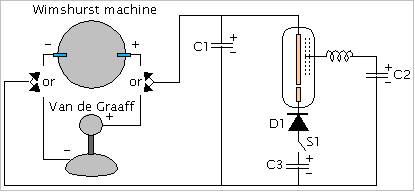This work is based on a circuit by Aaron Murakami in an attempt to replicate the EV Gray tube wherein he was able to repeatably get a radiant event. His video demonstrating this radiant event is here. In the video, the event is a green flash that occurs as one of the capacitors discharges down from 1000V. It's accompanied by a current in the coil strong enough to repel the magnet on the coil as this other video of his demonstrates.
This can be referred to it as "colliding positives" since two high voltage potentials are collided with each other during the event when they are both positive relative to ground, ground being a common low voltage point in the circuit that they both move towards but not Earth ground as this circuit is floating.
|
In doing this, most people use a high voltage, relatively high current power supply. This leads to the possiblity that the radiant event is just C2 above discharging quickly into the coil and the strength of the current being due entirely to the quickness of the discharge. This is not proven to be the case and is in dispute.
My question is whether adding more concentric grids will enhance the effect. I'd also like to see if the effect can be produced with a high voltage but very low current power supply. Putting all my cards on the table, my speculation is that the interaction within the tube may be tapping into quantum vacuum energy (also called zero point energy or ZPE) and enhancing the current through the coil. I guess this because the 300 watt small single disk testatika had only one grid cylinder in its pots whereas the 3kW 50cm dual disk testatika had 20 grid cylinders and from what we know for certain of the geometry in these pots, they are very similar to the Gray tube.
June 12 2009
I started out with C1 as a 4kV, 4uF capacitor and C2 as a 5kV, 5uF capacitor as in the photo on the left below but the tiny amount of current from the Van de Graaff machine was unable to charge up the relatively large capacity C1 very quickly. I then realized that the Van de Graaff machine was a capacitor and the C1 wasn't needed at all so I removed it as can be see in the photo on the right. From the photo you can see that I also added my Fluke high voltage probe so I could measure what was happening on C2.
|
|
|
So the result was this circuit without C1.
|
However, the meter showed that C2 was charging very slowly, taking long to get even to a few hundred volts so I replaced C2 with the homemade capacitor in the photo below with a much lower capacitance of around 340 picofarads. It charged much faster up to 1500 volts. It's an aluminium foil capacitor wrapped around a PVC tube with polyethylene as dielectric.
|
|
While I did get arcing to the grid and arcing across the spark gap, so far no radiant event. However, the capacitor does charge up to around 1500 volts and then rapidly drops to around 500 volts. No green flash is seen in the Gray tube at the time. This may be because the current is too small to see it or it may be because something is arcing somewhere else at the time.
The video below demonstrates where I am as of June 12.



